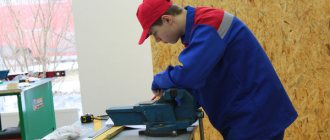Who is a slinger and what does he do?
Slingers are needed at sites where large or heavy loads are planned to be moved. They work closely with crane operators and are responsible for securing loads using slings (hence the name of the profession). Slings are metal cables or strong ropes with loops or hooks at the end. After completing his part of the work, the slinger signals the crane operator that the load is securely secured and its movement begins.
It is very important that the strapping is carried out by a qualified specialist. If the load is poorly secured, it may fall from a height, which can lead to injury to workers or damage to equipment. There are cases where a crane fell as a result of a broken sling.
Job responsibilities of a slinger
From the moment when the ends of the slings were secured to the hook until the load was lowered at the final point of movement, a large number of manipulations were performed. Not only the safety of inventory, but often also the lives of people depends on the level of execution of all these actions. Responsibilities of the slinger:
- preliminary preparation of the site for unloading. The place must be level. If necessary, the surface is covered with pallets or other blind area. The spatial arrangement of the cargo is planned;
- cargo check. This includes determining the weight in order to choose the optimal sling option - not too thick, but reliable. Select the fastening method: with loops or hooks;
- the material for fixation is selected: cable, ropes or chains;
- fixing slings. It is important to secure the load correctly. The harness should not be twisted, could not slip or break;
- giving the load the desired position. This is important for bulky items. They have a high windage, which reduces the stability of lifting equipment. If positioned incorrectly, the crane may overturn;
- correct the actions of the crane operator. For this purpose, a system of signs has been developed that the slinger must know;
- unhook the load.
In addition, the slinger must be able to provide first aid and skillfully handle fire extinguishing equipment. Depending on the specifics of the organization, job descriptions may contain additional requirements. In any case, a high level of specialist training is required. To confirm their skills and abilities, slingers periodically undergo certification.
What a slinger should know and be able to do
The job requires candidates to have a good stock of theoretical knowledge and, more importantly, practical skills. They must have an impeccable knowledge of the technology for performing various operations, the principles and techniques of slinging all kinds of cargo. One of the professional responsibilities is the choice of tools and equipment. To do this, the slinger must have the skills to determine the physical parameters of the load.
The specifics of the profession are such that in addition to special knowledge, you also need to have other skills and qualities:
- physical training. The slings are mostly made of metal and have a decent weight. And you have to fasten them by holding them in weight;
- good eye. A specialist often has to determine the physical parameters of a load “on the fly.” Since other calculation methods or accompanying documentation may not be available;
- excellent coordination. Weights have to be secured at heights - structures, platforms, building elements. Often work is carried out on sites cluttered with other objects, between which you have to maneuver;
- the ability to communicate using special signs. This makes it possible to coordinate the actions of the lifting mechanism operator and other slingers;
- speed of reaction. Lifting heavy loads is dangerous work. It is important to be able to quickly navigate a changed situation and make the right decision;
- attentiveness and responsibility. Mistakes are unacceptable, as they lead to irreversible consequences.
Categories of ranks
There are five categories of slingers, from 2 to 6. Each of them is assigned to a specialist with a certain level of knowledge and skills. The highest - 6th category, representing the most qualified employees, has the highest wage tariff. This does not mean that the 2nd category of profession is less in demand.
For enterprises working with small, uncomplicated loads, it is more profitable to hire a low-category slinger who will also do his job efficiently.
Requirements for categories
Responsibilities of slingers of the 2nd category
:
- Attaching to slings, tying simple loads up to 5 tons, as well as scaffolding no more than 3 meters long;
- Escort, control of cargo during movement, its stowage;
- Unhooking the slings after lowering the weight;
- Interaction with the crane operator using special signals;
- Control of sling expiration dates.
Required basic knowledge of the profession:
- Determining the mass of the load by eye;
- Calculation of attachment points to slings;
- Algorithm of actions during slinging;
- What slings, where to use (ropes, cables, chains);
- Calculation of the load on the sling, crane boom.
- Safety precautions at hazardous enterprises.
- Providing first aid.
Responsibilities of 3rd category specialists
to all of the above, plus:
- Tolerance for masses from 5 to 25 tons;
- Operations with timber up to 6 meters long;
- Cargo splicing using knotting method;
- Loading heavy loads onto machinery and scaffolding.
Additional information you need to know:
- How to calculate the center of gravity;
- Rules for stowing medium-complex cargo;
- The specifics of the functioning of gripping mechanisms;
- Methods of fastening slings and transportation in different conditions.
Responsibilities of slingers of the 4th category
professions are complemented by work:
- With masses of more than 25 tons;
- The length of the forest is over 6 meters;
- Cargoes that require careful handling.
In
, the responsibilities of 5th category specialists
include:
- Complete organization of the technical process for loading, unloading and moving;
- Handling complex loads up to 50 tons;
- Skills in handling crane equipment and other similar equipment.
The
responsibilities of specialists of the 6th category
include a complete list of all knowledge and skills, plus access to masses over 50 tons.
Pros and cons of the profession
The main advantage of the profession is the ability to perform part-time duties. Due to the fact that representatives of the profession must have a large list of skills, the possibility of using these skills in other areas is not excluded. There is a shortage of representatives of this profession in the labor market. But often the enterprise does not have the opportunity to load the slinger with the required amount of work. Therefore, part-time work is a fairly common fact.
Another important point for career growth is that a highly qualified specialist will be able to get a highly paid position in a large enterprise. It should be noted that for rapid career growth, a higher technical education is necessary.
The disadvantages of the profession include:
- low base salary. Specialists with extensive work experience, a high professional rank or a wide range of useful skills can count on a decent level of remuneration;
- If you do not have a higher technical education, then the prospects for career growth are very doubtful. A specialist can only choose the most attractive offer among employers;
- very often you have to work in unfavorable conditions. In open areas the situation depends on the weather, while in workshops and warehouses heat, dust, smoke or high humidity are annoying;
- great physical activity. Although you don’t have to drag the load itself, the weight of the slings is also decent and the fatigue from dragging them is noticeable. Especially at the end of a work shift;
- the likelihood of injury at work is high. The slinger is constantly forced to be in close proximity to lifting mechanisms and moving cargo. There is always a chance that something will hit or fall;
- great responsibility. The slinger should not make a mistake, as this can lead to serious problems.
Due to the specific nature of the job, the overwhelming majority of people hired for the position are men. The need to pass certification exams and the low prestige of the specialty do not add to the desire to work in this particular field.
Slinger ranks
The level of skill of a slinger is determined by the rank assigned to him. There are five of them in total, starting with the second and ending with the sixth. They are assigned alternately depending on the growth of the applicant’s skills and abilities. The highest is the sixth. It is assigned to the most experienced specialists and is assessed with the highest tariff rates. But this does not mean at all that initial second-class workers are not in demand at all.
For example, companies involved in loading simple and small cargo are more willing to hire less qualified personnel. The reason is simple - savings on the slinger's wage fund.
Slinger 2nd category
Main responsibilities:
- lashing of small loads weighing no more than five tons or molded products up to three meters long;
- control the movement of cargo and, if necessary, accompany it;
- removing the slings after lowering;
- during work, interact with the crane operator using special signals, give recommendations on moving weights;
- monitor the condition of the slings and promptly replace worn ones with new ones.
Basic knowledge for performing slinging work:
- the ability to determine the approximate mass of objects with a slight deviation;
- quick determination of points for fastening slings;
- know the manipulation algorithm during slinging;
- what slings (ropes, chains, cables) can be used and where;
- determining the load force on a crane sling or boom;
- safety rules when performing rigging work;
- first aid for injury.
Slinger 3rd category
Responsibilities of the specialist:
- work with loads weighing from five to 25 tons;
- movement of long items up to 6 meters is allowed;
- has the right to splice several cargoes into knots;
- loading onto pallets and transport mechanisms.
Compared to 2nd category specialists, you must additionally know and be able to:
- determine the center of gravity of a complex load;
- master methods of storing goods of medium complexity;
- specifics of functioning of mechanisms and devices intended for gripping;
- know the existing methods of fastening slings.
Slinger 4th category
Additional responsibilities:
- are allowed to work with cargo weighing more than 25 tons;
- can attach lengths over six meters;
- secure weights that require special treatment.
Slinger 5th category
In addition to everything that a specialist of the fourth category should have, a slinger of the 5th category is obliged to:
- ensure the technological process for tying, lifting, moving and lowering all types of weights in full;
- move cargo weighing up to 50 tons inclusive;
- have the skills to work with lifting equipment (including a crane) and other mechanisms.
Slinger 6th category
The responsibilities of a 6th category specialist include the entire range of previously listed functionality plus access to cargo weighing more than 50 tons. He must be able to tie loads over six meters long; fasten particularly critical mechanisms, parts and assemblies; master the methodology of slipway and sectional assembly (disassembly). Professionals are involved in the installation of apparatus, machines, structures and buildings using lifting equipment.
He must have an impeccable knowledge of the rules for slinging especially critical cargo, as well as methods of securing cargo in order to prevent their deflection or deformation during movement.
§ 304. Slinger (4th category)
4th category
Characteristics of work. Slinging and lashing of simple products, parts, timber (up to 3 m long) and other similar loads weighing over 25 tons for lifting, moving and stacking. Slinging and tying of moderately complex loads, timber loads (over 3 to 6 m in length), products, parts and assemblies with their installation on a machine, scaffolding and other mounting devices and mechanisms, as well as similar loads weighing over 5 to 25 tons for lifting them , moving and laying. Slinging and tying of timber cargo (over 6 m in length), products, parts and assemblies requiring increased care, technological equipment and related structures, products, assemblies, machines and mechanisms directly during slipway and sectional assembly and disassembly, as well as during assembly and dismantling of machines, apparatus, structures of prefabricated elements of buildings and structures and similar complex loads weighing up to 5 tons for their lifting, installation, movement and stacking. Braiding the ends of the slings. Selection of slings in accordance with the weight and type of cargo.
Must know: methods of slinging heavy loads; arrangement of load-handling devices used when lifting and moving loads to protect them from deflection and damage; rules and methods for splicing slings; service life of slings and their load capacity.
Training and certification of slingers
You can obtain a slinger qualification remotely or in training centers. The volume of the training course directly depends on what level the future specialist wants to receive. The program includes the following items:
- design, classification and operating rules of crane installations;
- safety equipment;
- containers and devices for securing cargo;
- methods of fastening the ends of metal cables;
- criteria allowing to reject containers or devices for lifting loads;
- techniques for safely moving heavy objects using a crane;
- performing work using lifting mechanisms;
- existing types of cargo and rules for their slinging;
- methodology for performing manipulations for loading, unloading and storing various cargoes;
- requirements for the location of loading and unloading operations;
- installation and construction;
- safety rules when working at the enterprise;
- first aid to the victim.
Certification consists of the fact that the applicant must pass an exam on the material studied. Based on its results, specialists receive certificates, and the selection committee enters their data into a special protocol.
§ 305. Slinger (5th category)
5th category
Characteristics of work. Slinging and tying of moderately complex loads, timber (over 3 to 6 m in length), products, parts and assemblies with their installation on a machine, scaffolding and other mounting devices and mechanisms, as well as similar loads weighing over 25 tons for lifting, moving and styling Slinging and tying of timber cargo (over 6 m in length), especially critical products, machine components and mechanisms directly during slipway and sectional assembly and disassembly, as well as during assembly and disassembly of machines, apparatus, structures of prefabricated elements of buildings and structures and similar complex loads of mass over 5 to 50 tons for lifting, moving and laying.
Must know: the design of devices used when lifting and moving loads to protect them from deflection and damage; methods and timing of testing slings.






